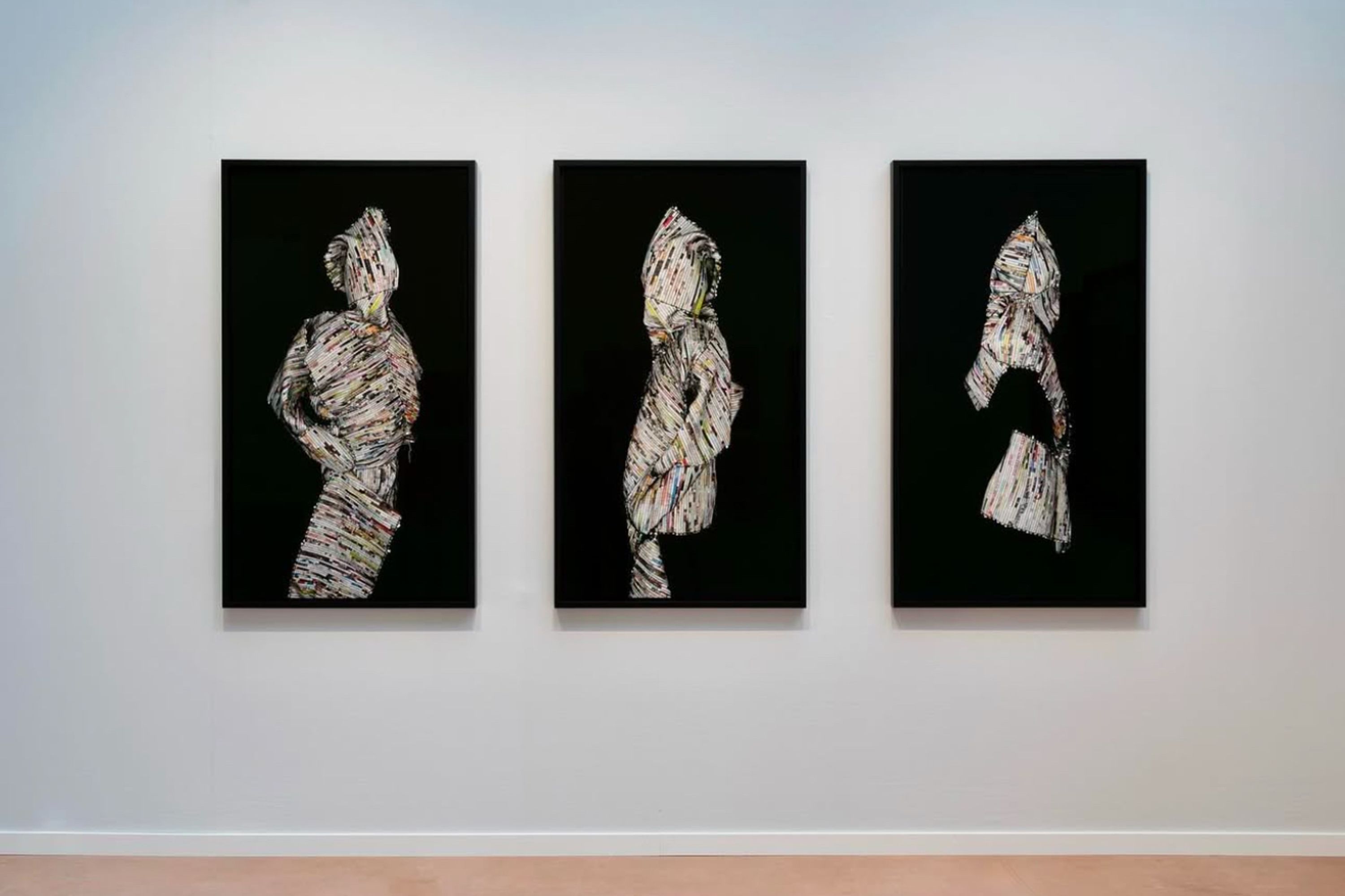SHREDSPhoto Series
20245 Artworks
s, 2024
SHREDS (2024) examines the material aspects of a world in constant flux, often defined by written text and printed images that attempt to describe a moment. Texere, “to weave” in Latin, is the etymological origin of both “text” and “textile”. In this series, text and textile fuse together as strips of newspaper are cut, folded once to mimic a flat weft, and are then woven together with cotton warps, forming a tapestry. The resulting matter is more structural than softer textiles, resulting in angular forms as well as strong curving lines.
Here the textual reference of an angle (or angles) defines both structural form and individual points of view. It is a subjective take on an event, a momentary glimpse into something that happens and is subsequently forgotten, like a crumpled newspaper. Lessons of history that fall into oblivion, reappearing in new form in another corner of the world. Genocides shock us to our cores, only to reoccur decades later.
In this weave, the ribbons of folded text are used as the weft, woven together to form shapes that surge against the deepest black. The warp weaves the strips together, masking and revealing words that may—or may not—hold meaning. Alia Ali has transformed text into textile, adopting a traditional training method used by novice weavers in Indonesia. This process is interesting in that trash is transformed into a tool to further knowledge and perpetuate heritage skill, as weaving is itself a tapestry of history in both form and motif. As the eye travels over the paper strips, the word “Honda” might appear, evoking memories of a friend’s car. Or King Leopold; just a name, yet it holds the harsh and not so distant memory of a despot, a killer, a man who ravaged modern day Congo, slaughtering over ten million souls.(3) Bits and pieces, shreds of history, increments of time, brief moments of focus and disruption.
Here the -cludes emerge from the blackness and submerge into negative space, invisible to the eye yet starkly three-dimensional. Aligned in a row, the five works of the series—S, H, R, E and D—spell out the title of the series in a pixelated version of warp and weft. Right to left or left to right, here we are in a world of biassed views. Right, left, extreme right and extreme left, the weft of our world has made it so that we cannot trust what we see and what we don’t.
In a stark departure from Ali’s earlier series, vibrant colours and carefully situated motifs are replaced by printed paper, muted colours, rigid form and blurred insignia.
SHREDS questions our own perceptions and the world(s) we live in and construct for ourselves. Are we the -cludes, wrapped in the fragmented worlds of other words, distrustful of information sources? Our need to double-check is not only exhausting but virtually impossible, perpetually cross-referencing in an attempt to understand our own perception of the truth, both as individuals and as a society. We drown ourselves in a deluge of (mis)information, pushing our sanity into forming incredibly secluded versions of self and impressions of other people, cultures, and places. We are certain of our knowledge yet we know nothing at all, other than the quick swipes that form cognisance of our environments, both local and global.
In these enigmatic photographs, the artist invites the viewer to approach the work from both a micro and macro perspective: zooming in to read the texts only to discover that what is meant to convey ideas is now seamed together, defying comprehension. We seek clues within the images to reform meaning into imagination, then stand back to take in the full scheme of these photographs, which individually and collectively produce a puzzle of images. As we step back, time is lost. If there is no date in sight, what is a “current event”? Today’s news is tomorrow’s past. Eventually we zoom out to see the weave, wrapped and warped around bodies, as disposable as crumpled newspaper—to be tossed or recycled, used to clean windows, package gifts, or hold street foods. In her works, Ali calls to the viewers (and readers) to move beyond the digitised cells into which we have secluded ourselves and to actively embrace our curiosity. Isn’t it our responsibility to learn, to read, to seek, to question and to remember the errors of the past and put them into perspective? SHREDS reminds us to look beyond the subjective to appreciate the multiple points of view that can exist all at once: past, present and future.
___________________________________________________ 3. Arthor Hochschild recounts the lost history of Horror in the Belgian congo. Wilson Center. (n.d.). https://www.wilsoncenter.org/article/author-hochschild-recounts-lost-history-horror-the-belgian-congo

